Toshiba B-EX4T2-HS12-QM-R User Manual
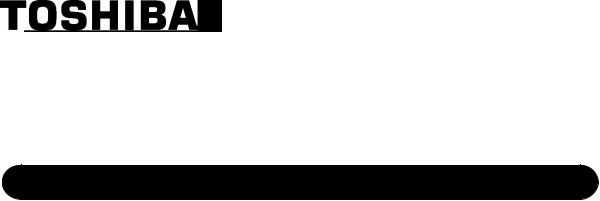
TOSHIBA Barcode Printer
B-EX4T2 SERIES
Owner’s Manual Mode d’emploi Bedienungsanleitung
Manual de instrucciones Gebruikershandleiding Manuale Utente
Manual do Utilizador
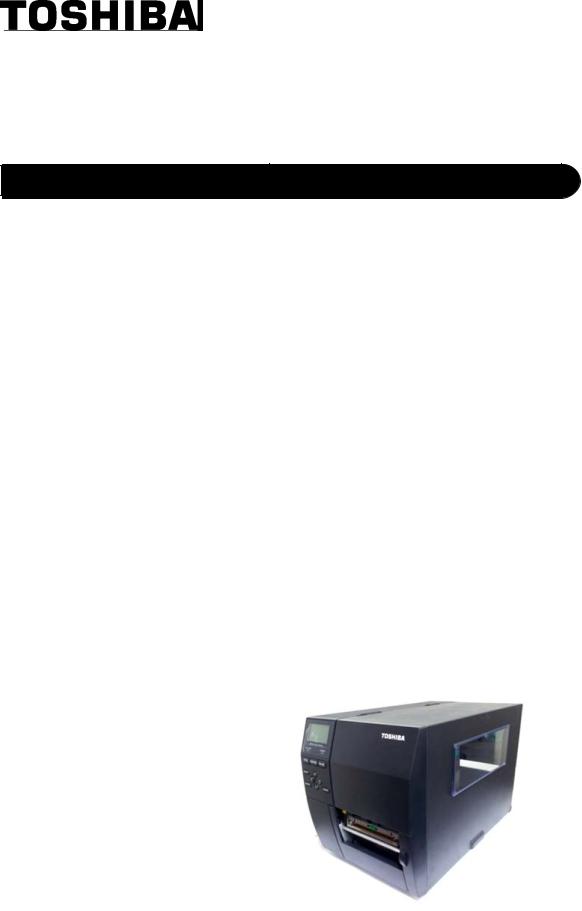
TOSHIBA Barcode Printer
B-EX4T2 SERIES
 Owner's Manual
Owner's Manual

CE Compliance (for EU only)
This product complies with the requirements of EMC and Low Voltage Directives including their amendments.
VORSICHT:
•Schallemission: unter 70dB (A) nach DIN 45635 (oder ISO 7779)
•Die für das Gerät Vorgesehene Steckdose muß in der Nähe des Gerätes und leicht zugänglich sein.
Centronics is a registered trademark of Centronics Data Computer Corp.
Microsoft is a registered trademark of Microsoft Corporation.
Windows is a trademark of Microsoft Corporation.
This equipment has been tested and found to comply with the limits for a Class A digital device, pursuant to Part 15 of the FCC Rules. These limits are designed to provide reasonable protection against harmful interference when the equipment is operated in a commercial environment. This equipment generates, uses, and can radiate radio frequency energy and, if not installed and set in accordance with the instruction manual, may cause harmful interference to radio communications. Operations of this equipment in a residential area is likely to cause harmful interference in which case the user will be required to correct the interference at his own expense.
(for USA only)
Changes or modifications not expressly approved by the manufacturer for compliance could void the user’s authority to operate the equipment.
“This Class A digital apparatus meets all requirements of the Canadian Interference-Causing Equipment Regulations.”
“Cet appareil numérique de la classe A respecte toutes les exigences du Règlement sur le matériel brouilleur du Canada.”
(for CANADA only)
N258 IP20
< For EU Only >
TOSHIBA TEC Europe Retail Information Systems S.A. Rue de la Célidée 33 BE-1080 Brussels
Copyright © 2012
by TOSHIBA TEC CORPORATION All Rights Reserved
6-78 Minami-cho, Mishima-shi, Shizuoka-ken, JAPAN

Waste Recycling information for users:
Following information is only for EU-member states:
The use of the crossed-out wheeled bin symbol indicates that this product may not be treated as general household waste.
By ensuring this product is disposed of correctly you will help prevent
potential negative consequences for the environment and human health, which could otherwise be caused by inappropriate waste handling of this product. For more detailed information about the take-back and recycling of this product, please contact your supplier where you purchased the product.
Precautions for the handling of Wireless Communication Devices
Wireless LAN Module: SD-Link 11g
RFID Module: TEC-RFID-EU1 (B-EX700-RFID-H1-QM-R)
For Europe
This device was tested and certified by Notified Body.
Hereby, Toshiba TEC Corporation declares that this device is in compliance with the essential requirements and other relevant provisions of Directive 1999/5/EC.
This equipment uses the radio frequency band which has not been standardised throughout the EU and EFTA countries. It can be used in the following countries.
Austria, Belgium, Bulgaria, Cyprus, Czech Republic, Denmark, Estonia, Finland, France, Hungary, Germany, Greece, Ireland, Italy, Latvia, Lithuania, Luxembourg, Malta, Netherlands, Poland, Portugal, Romania, Slovakia, Slovenia, Spain, Sweden, United Kingdom, Norway, Liechtenstein, Iceland, Switzerland
For USA
This device complies with Part 15 of the FCC Rules.
Operation is subject to the following two conditions:
(1)This device may not cause harmful interference, and
(2)This device must accept any interference received, including interference that may cause undesired operation.
Changes or modification not expressly approved by manufacturer for compliance could void the user’s authority to operate the equipment.
For Canada
Operation is subject to the following two conditions:
(1)This device may not cause interference, and
(2)This device must accept any interference, including interference that may cause undesired operation of the device.
For Taiwan
Caution
For safety
Do not operate this product in locations where its use may be prohibited. For example, in an aeroplane or hospital. If you are unsure whether operation is permitted, please refer to and follow the airline company or medical institution guidelines.
Otherwise, flight instrument or medical equipment may be affected, causing a serious accident.
This product may affect the operation of some implanted cardiac pacemakers and other medically implanted equipment. Pacemaker patients should be aware that the use of this product in close proximity to a pacemaker might cause the device to malfunction.
If you have any reason to suspect that interference is taking place, immediately turn off the product and contact your TOSHIBA TEC sales agent.
Do not disassemble, modify, or repair the product as doing so may cause injury.
Modification is also against the Laws and Regulations for Radio Equipment. Please ask your TOSHIBA TEC sales agent for repair.

Safety Summary |
ENGLISH VERSION EO1-33094 |
Safety Summary
Personal safety in handling or maintaining the equipment is extremely important. Warnings and Cautions necessary for safe handling are included in this manual. All warnings and cautions contained in this manual
should be read and understood before handling or maintaining the equipment.
Do not attempt to effect repairs or modifications to this equipment. If a fault occurs that cannot be rectified using the procedures described in this manual, turn off the power, unplug the machine, and then contact your authorised TOSHIBA TEC representative for assistance.
Meanings of Each Symbol
This symbol indicates warning items (including cautions).
Specific warning contents are drawn inside the  symbol. (The symbol on the left indicates a general caution.)
symbol. (The symbol on the left indicates a general caution.)
This symbol indicates prohibited actions (prohibited items).
Specific prohibited contents are drawn inside or near the  symbol. (The symbol on the left indicates “no disassembling”.)
symbol. (The symbol on the left indicates “no disassembling”.)
This symbol indicates actions which must be performed.
Specific instructions are drawn inside or near the symbol.
(The symbol on the left indicates “disconnect the power cord plug from the outlet”.)
|
|
|
|
|
WARNING |
This indicates that there is the risk of death or serious injury if the |
|
|||||
|
|
|
|
|
|
|||||||
|
|
|
|
|
machine is improperly handled contrary to this indication. |
|
||||||
|
|
|
|
|
|
|
|
|
|
|
|
|
|
|
|
Use only specified |
Do not use voltages other than |
|
|
Prohibited |
Do not plug in or unplug the power |
|
|||
|
|
|
|
|
|
|||||||
|
|
|
the AC voltage specified on the |
|
|
cord with wet hands as this may |
||||||
|
|
|
AC voltage. |
|
|
|
||||||
|
|
|
|
|
|
rating plate, as this may cause |
|
|
|
cause electric shock. |
||
|
|
|
|
|
|
fire or electric shock. |
|
|
|
|
||
|
|
|
|
|
|
|
|
|
|
|
|
|
|
|
|
|
|
|
|
|
|
|
|
|
|
|
|
|
|
Prohibited |
If the machine shares the same |
|
|
|
Prohibited |
|
Do not place metal objects or |
||
|
|
|
|
|
|
|
|||||||
|
|
|
|
electrical outlet, with any other |
|
|
|
|
water-filled containers (flower |
||||
|
|
|
|
|
appliance that consumes a large |
|
|
|
|
|
vases, flower pots or mugs etc) on |
||
|
|
|
|
|
|
|
|
|
|||||
|
|
|
|
|
amount of power, the voltage will |
|
|
|
|
top of the machine. If metal |
|||
|
|
|
|
|
fluctuate widely each time these |
|
|
|
|
objects or spilled liquids enter the |
|||
|
|
|
|
|
appliances operate. Be sure to |
|
|
|
|
machine, this may cause fire or |
|||
|
|
|
|
|
provide an exclusive outlet for |
|
|
|
|
electric shock. |
|||
|
|
|
|
|
the machine as this may cause |
|
|
|
|
|
|||
|
|
|
|
|
fire or electric shock. |
|
|
|
|
|
|||
|
|
|
|
|
|
|
|
|
|
||||
|
|
|
|
Prohibited |
Do not insert or drop metal, |
|
|
|
|
Prohibited |
|
Do not scratch, damage or modify |
|
|
|
|
|
|
|
|
|
||||||
|
|
|
|
flammable or other foreign |
|
|
|
|
|
the power cords. Do not place |
|||
|
|
|
|
|
objects into the machine through |
|
|
|
|
|
|
heavy objects on, pull on, or |
|
|
|
|
|
|
|
|
|
|
|
||||
|
|
|
|
|
ventilation slits, as this may |
|
|
|
|
excessively bend the power cords, |
|||
|
|
|
|
|
cause fire or electric shock. |
|
|
|
|
as this may cause fire or electrical |
|||
|
|
|
|
|
|
|
|
|
|
|
|
|
shock. |
|
|
|
|
|
|
|
|
|
|
|
|
|
|
|
|
|
|
|
|
|
|
|
|
|
|
|
|
|
|
|
|
|
|
|
|
|
|
|
|
|
|
|
|
|
|
Disconnect |
If the machine is dropped or the |
|
|
|
Disconnect |
|
Continued use of the machine in an |
||
|
|
|
|
|
|
|
|
||||||
|
|
|
|
cabinet is damaged, turn off the |
|
|
|
|
|
abnormal condition (the machine is |
|||
|
|
|
|
the plug. |
|
|
|
the plug. |
|
||||
|
|
|
|
|
power switch and disconnect the |
|
|
|
|
|
producing smoke or a strange |
||
|
|
|
|
|
power cord plug from the outlet, |
|
|
|
|
|
smell) may cause fire or electric |
||
|
|
|
|
|
and then contact your authorised |
|
|
|
|
shock. In these cases, immediately |
|||
|
|
|
|
|
TOSHIBA TEC representative |
|
|
|
|
turn off the power switch and |
|||
|
|
|
|
|
for assistance. Continued use of |
|
|
|
|
disconnect the power cord plug |
|||
|
|
|
|
|
a damaged machine may cause |
|
|
|
|
from the outlet. Then, contact your |
|||
|
|
|
|
|
fire or electric shock. |
|
|
|
|
authorised TOSHIBA TEC |
|||
|
|
|
|
|
|
|
|
|
|
|
|
|
representative for assistance. |
|
|
|
|
|
|
|
|
|
|
|
|
|
|
( i )

Safety Summary |
|
|
|
|
|
|
|
|
ENGLISH VERSION EO1-33094 |
||||||
|
|
|
|
|
|
|
|
|
|
|
|
|
|
|
|
|
|
|
|
|
|
|
|
|
|
|
|
|
|
|
|
|
|
|
|
Disconnect |
If foreign objects (metal |
|
|
|
|
|
Disconnect |
When unplugging the power cords, |
|
||
|
|
|
|
|
|
|
|
|
|
||||||
|
|
|
|
fragments, water, liquids) enter |
|
|
|
|
|
be sure to hold and pull on the plug. |
|||||
|
|
|
|
the plug. |
|
the machine, turn off the power |
|
|
|
|
|
the plug. |
Pulling on the cord may cut or |
||
|
|
|
|
|
|
switch and disconnect the power |
|
|
|
|
|
|
|
expose the internal wires and cause |
|
|
|
|
|
|
|
|
|
|
|
|
|
|
|||
|
|
|
|
|
|
cord plug from the outlet, and |
|
|
|
|
|
|
|
fire or electric shock. |
|
|
|
|
|
|
|
then contact your authorised |
|
|
|
|
|
|
|
|
|
|
|
|
|
|
|
TOSHIBA TEC representative |
|
|
|
|
|
|
|
|
|
|
|
|
|
|
|
for assistance. Continued use of |
|
|
|
|
|
|
|
|
|
|
|
|
|
|
|
the machine in that condition may |
|
|
|
|
|
|
|
|
|
|
|
|
|
|
|
cause fire or electric shock. |
|
|
|
|
|
|
|
|
|
|
|
|
|
Connect a |
Ensure that the equipment is |
|
|
|
|
|
No |
Do not remove covers, repair or |
|
||
|
|
|
|
|
|
|
|
|
|
||||||
|
|
|
|
properly grounded. Extension |
|
|
|
|
|
modify the machine yourself. |
|||||
|
|
|
|
grounding wire. |
|
|
|
|
|
disassembling. |
|||||
|
|
|
|
|
|
cables should also be grounded. |
|
|
|
|
|
|
|
Contact your TOSHIBA TEC |
|
|
|
|
|
|
|
Fire or electric shock could |
|
|
|
|
|
|
|
representative for assistance. You |
|
|
|
|
|
|
|
occur on improperly grounded |
|
|
|
|
|
|
|
may be injured by high voltage, |
|
|
|
|
|
|
|
equipment. |
|
|
|
|
|
|
|
very hot parts or sharp edges inside |
|
|
|
|
|
|
|
|
|
|
|
|
|
|
|
the machine. |
|
|
|
|
|
|
|
|
|
|
|
|
|
|
|
|
|
|
|
|
|
|
|
|
|
|
|
|
|
|
|
|
|
|
|
|
|
Prohibited |
Do not use a spray cleaner |
|
|
|
|
|
Prohibited |
Care must be taken not to injure |
|||
|
|
|
|
|
|
|
|
|
|
||||||
|
|
|
|
containing flammable gas for |
|
|
|
|
|
yourself with the printer paper |
|||||
|
|
|
|
|
|
cleaning this product, as this may |
|
|
|
|
|
|
|
cutter. |
|
|
|
|
|
|
|
|
|
|
|
|
|
|
|||
|
|
|
|
|
|
cause a fire. |
|
|
|
|
|
|
|
|
|
|
|
|
|
|
|
|
|
|
|
|
|
|
|
|
|
|
|
|
This indicates that there is the risk of personal Injury or damage to |
||||
|
|
|
|||||
|
|
|
CAUTION objects if the machine is improperly handled contrary to this indication. |
||||
|
|
|
|||||
Precautions |
|
|
|
|
|||
The following precautions will help to ensure that this machine will continue to function correctly. |
|
||||||
• Try to avoid locations that have the following adverse conditions: |
|
|
|||||
* |
Temperatures out of the specification |
* |
Direct sunlight |
* |
High humidity |
||
* |
Shared power source |
* |
Excessive vibration |
* |
Dust/Gas |
||
•The cover should be cleaned by wiping with a dry cloth or a cloth slightly dampened with a mild detergent solution. NEVER USE THINNER OR ANY OTHER VOLATILE SOLVENT on the plastic covers.
•USE ONLY TOSHIBA TEC SPECIFIED paper and ribbons.
•DO NOT STORE the paper or ribbons where they might be exposed to direct sunlight, high temperatures, high humidity, dust, or gas.
•Ensure the printer is operated on a level surface.
•Any data stored in the memory of the printer could be lost during a printer fault.
•Try to avoid using this equipment on the same power supply as high voltage equipment or equipment likely to cause mains interference.
•Unplug the machine whenever you are working inside it or cleaning it.
•Keep your work environment static free.
•Do not place heavy objects on top of the machine, as these items may become unbalanced and fall causing injury.
•Do not block the ventilation slits of the machine, as this will cause heat to build up inside the machine and may cause fire.
•Do not lean against the machine. It may fall on you and could cause injury.
•Unplug the machine when it is not used for a long period of time.
•Place the machine on a stable and level surface.
Request Regarding Maintenance
•Utilise our maintenance services.
After purchasing the machine, contact your authorised TOSHIBA TEC representative for assistance once a year to have the inside of the machine cleaned. Dust will build up inside the machines and may cause a fire or a malfunction. Cleaning is particularly effective before humid rainy seasons.
•Our preventive maintenance service performs periodic checks and other work required to maintain the quality and performance of the machine.
For details, please consult your authorised TOSHIBA TEC representative.
•Do not expose the machine to insecticides or other volatile solvents. This may cause the cabinet, or other parts, to deteriorate and may cause the paint to peel.
Notification (for Turkey)
EEE Yönetmeliğine Uygundur
(ii)
ENGLISH VERSION EO1-33094
|
|
|
TABLE OF CONTENTS |
|
|
|
|
|
Page |
1. |
PRODUCT OVERVIEW ....................................................................................................... |
E1- 1 |
||
|
1.1 |
Introduction................................................................................................................. |
E1- 1 |
|
|
1.2 |
Features ..................................................................................................................... |
E1- 1 |
|
|
1.3 |
Unpacking................................................................................................................... |
E1- 1 |
|
|
1.4 |
Accessories ............................................................................................................... |
E1- 2 |
|
|
1.5 |
Appearance ................................................................................................................ |
E1- 3 |
|
|
|
1.5.1 |
Dimensions ............................................................................................................... |
E1- 3 |
|
|
1.5.2 |
Front View................................................................................................................. |
E1- 3 |
|
|
1.5.3 |
Rear View ................................................................................................................. |
E1- 3 |
|
|
1.5.4 |
Operation Panel ........................................................................................................ |
E1- 4 |
|
|
1.5.5 |
Interior ....................................................................................................................... |
E1- 4 |
|
1.6 |
Options ....................................................................................................................... |
E1- 5 |
|
2. |
PRINTER SETUP ................................................................................................................ |
E2- 1 |
||
|
2.1 |
Installation .................................................................................................................. |
E2- 2 |
|
|
2.2 |
Connecting the Power Cord ........................................................................................ |
E2- 3 |
|
|
2.3 |
Loading Supplies ........................................................................................................ |
E2- 4 |
|
|
|
2.3.1 |
Loading the Media .................................................................................................... |
E2- 5 |
|
|
2.3.2 |
Loading the Ribbon.................................................................................................. |
E2-10 |
|
2.4 |
Connecting the Cables to Your Printer ....................................................................... |
E2-12 |
|
|
2.5 |
Turning the Printer ON/OFF....................................................................................... |
E2-13 |
|
|
|
2.5.1 |
Turning ON the Printer............................................................................................. |
E2-13 |
|
|
2.5.2 |
Turning OFF the Printer........................................................................................... |
E2-13 |
|
2.6 |
Printer Setting........................................................................................................................... |
E2-14 |
|
|
|
2.6.1 |
User System Mode .................................................................................................. |
E2-15 |
|
|
2.6.2 |
Parameter Setting .................................................................................................... |
E2-16 |
|
|
2.6.3 |
Enabling LAN/WLAN ............................................................................................... |
E2-24 |
|
|
2.6.4 |
Basic Program Setting ............................................................................................. |
E2-24 |
|
|
2.6.5 |
Enabling Z-Mode...................................................................................................... |
E2-25 |
|
|
2.6.6 |
Automatic Calibration............................................................................................... |
E2-26 |
|
|
2.6.7 |
Dump Mode Setting ................................................................................................. |
E2-27 |
|
|
2.6.8 |
Logging .................................................................................................................... |
E2-29 |
|
|
2.6.9 |
System Mode ........................................................................................................... |
E2-30 |
|
|
2.6.10 |
Interface Setting....................................................................................................... |
E2-31 |
|
|
2.6.11 |
Real Time Clock (RTC)............................................................................................ |
E2-38 |
|
|
2.6.12 |
Copying Data to/from USB Memory ........................................................................ |
E2-39 |
|
2.7 |
Installing the Printer Drivers ....................................................................................... |
E2-40 |
|
|
|
2.7.1 |
Introduction .............................................................................................................. |
E2-40 |
|
|
2.7.2 |
General Description ................................................................................................. |
E2-40 |
|
|
2.7.3 |
Installing the Printer Driver ...................................................................................... |
E2-40 |
|
|
2.7.4 |
Preparation for installation ....................................................................................... |
E2-41 |
|
|
2.7.5 |
Installation under Windows2000/XP/Server2003 .................................................... |
E2-43 |
|
|
2.7.6 |
Installation under WindowsVista/Server2008/7/Server2008R2 .............................. |
E2-48 |
|
|
2.7.7 |
Installation under Windows2000 (USB with Plug & Play enabled) ......................... |
E2-51 |
|
|
2.7.8 |
Installation under WindowsXP/Server2003 (USB with Plug & Play enabled)......... |
E2-53 |
2.7.9Installation under Windows Vista/Server2008/7/Server2008R2
(USB with Plug & Play enabled) .............................................................................. |
E2-54 |
2.7.10 Uninstalling the Printer Driver .................................................................................. |
E2-55 |
2.8 Print Test ................................................................................................................... |
E2-58 |

ENGLISH VERSION EO1-33094
|
2.9 |
Position and Print Tone Fine Adjustment .................................................................. |
E2-60 |
|
|
|
2.9.1 |
Fine Adjustment ....................................................................................................... |
E2-60 |
|
2.10 |
Threshold Setting....................................................................................................... |
E2-67 |
|
|
2.11 |
Sensor Setting ........................................................................................................... |
E2-69 |
|
3. |
ONLINE MODE ................................................................................................................... |
E3- 1 |
||
|
3.1 |
Key Functions ............................................................................................................. |
E3- 1 |
|
|
3.2 |
LCD ............................................................................................................................ |
|
E3- 2 |
|
3.2 |
Operation Example ..................................................................................................... |
E3- 3 |
|
4. |
MAINTENANCE .................................................................................................................. |
E4- 1 |
||
|
4.1 |
Cleaning ..................................................................................................................... |
E4- 1 |
|
|
|
4.1.1 |
Print Head/Platen/Sensors ....................................................................................... |
E4- 1 |
|
|
4.1.2 |
Covers and Panels ................................................................................................... |
E4- 2 |
|
|
4.1.3 |
Optional Cutter Module............................................................................................. |
E4- 3 |
5. |
TROUBLESHOOTING ........................................................................................................ |
E5- 1 |
||
|
5.1 |
Error Messages .......................................................................................................... |
E5- 1 |
|
|
5.2 |
Possible Problems ...................................................................................................... |
E5- 4 |
|
|
5.3 |
Removing Jammed Media .......................................................................................... |
E5- 5 |
|
6. |
PRINTER SPECIFICATIONS .............................................................................................. |
E6- 1 |
||
7. |
SUPPLY SPECIFICATIONS................................................................................................ |
E7- 1 |
||
|
7.1 |
Media.......................................................................................................................... |
|
E7- 1 |
|
|
7.1.1 |
Media Type ............................................................................................................... |
E7- 1 |
|
|
7.1.2 Detection Area of the Transmissive Sensor ............................................................. |
E7- 3 |
|
|
|
7.1.3 Detection Area of the Reflective Sensor .................................................................. |
E7- 4 |
|
|
|
7.1.4 |
Effective Print Area ................................................................................................... |
E7- 4 |
|
|
7.1.5 |
RFID Tags................................................................................................................. |
E7- 6 |
|
7.2 |
Ribbon |
........................................................................................................................ |
E7- 8 |
|
7.3 |
Recommended Media and Ribbon Types ................................................................. |
E710 |
|
|
7.4 |
Care/Handling of Media and Ribbon ......................................................................... |
E717 |
|
APPENDIX 1 MESSAGES AND LEDS .................................................................................... |
EA1-1 |
|||
APPENDIX 2 INTERFACE ....................................................................................................... |
EA2-1 |
|||
APPENDIX 3 PRINT SAMPLES............................................................................................... |
EA3-1 |
|||
APPENDIX 4 GLOSSARIES .................................................................................................... |
EA4-1 |
|||
WARNING!
This is a Class A product. In a domestic environment this product may cause radio interference in which case the user may be required to take adequate measures.
CAUTION!
1.This manual may not be copied in whole or in part without prior written permission of TOSHIBA TEC.
2.The contents of this manual may be changed without notification.
3.Please refer to your local Authorised Service representative with regard to any queries you may have in this manual.
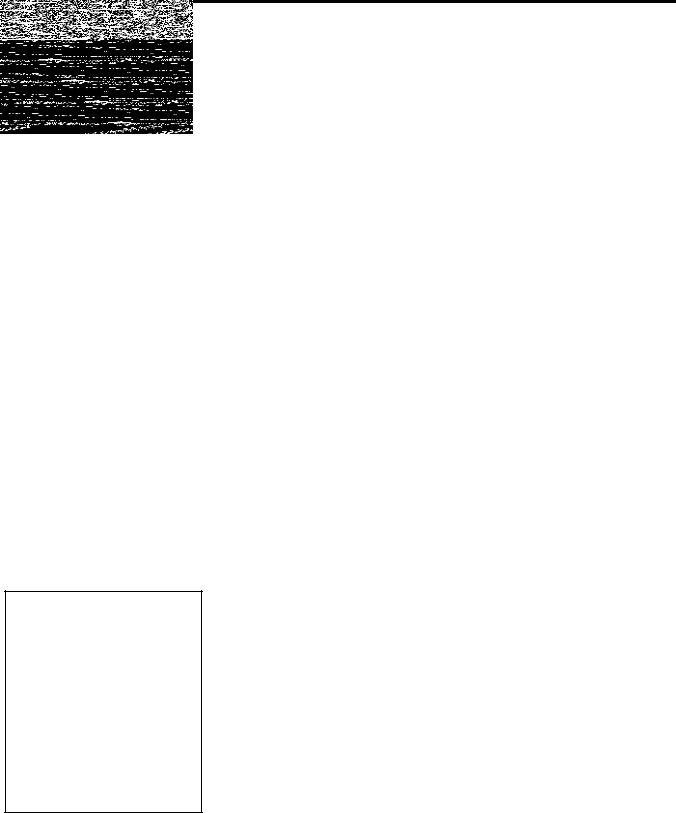
1. PRODUCT OVERVIEW |
ENGLISH VERSION EO1-33094 |
1.1 Introduction
1. PRODUCT OVERVIEW
1.1 Introduction
Thank you for choosing the TOSHIBA B-EX4T2 series bar code printer. This Owner’s Manual contains from general set-up through to how to confirm the printer operation using a test print, and should be read carefully to help gain maximum performance and life from your printer. For most queries please refer to this manual and keep it safe for future reference. Please contact your TOSHIBA TEC representative for further information concerning this manual.
1.2 Features
This printer has the following features:
•The print head block can be opened providing smooth loading of media and ribbon.
•Various types of media can be used as the media sensors can be moved from the centre to the left edge of the media.
•Web based functions such as remote maintenance and other advanced network features are available.
•Superior hardware, including the specially developed 8 dots/mm (203 dots/inch) thermal print head which will allow very clear print at a printing speed of 3, 6, 10, or 12 inches/sec. and 3, 5, 8, 10, or 12 inches/sec. with 11.8 dots/mm (300 dots/inch) thermal head. 23.6 dots/mm (600 dpi) thermal print head which will allow very clear print at a printing speed of 2, 3, 4, 5, or 6 inches/sec.
1.3 Unpacking
NOTES:
1.Check for damage or scratches on the printer. However, please note that TOSHIBA TEC shall have no liability for any damage of any kind sustained during transportation of the product.
2.Keep the cartons and internal packing for future transportation of the printer.
•Besides the optional Cutter Module, there is also an optional Peel off Module, RS-232C I/F card, Centronics I/F card, Expansion I/O Card, Wireless LAN I/F card, the RTC/USB host I/F card, HF band RFID mount kit and Narrow width platen kit.
Unpack the printer as per the Unpacking Instructions supplied with the printer.
E1- 1

1. PRODUCT OVERVIEW |
ENGLISH VERSION EO1-33094 |
1.4 Accessories
1.4Accessories
When unpacking the printer, please make sure all the following accessories are supplied with the printer.
Power cord
Safety precautions |
Quick installation manual |
CD-ROM(1pc.)
E1- 2

1. PRODUCT OVERVIEW |
ENGLISH VERSION EO1-33094 |
|
1.5 Appearance |
|
|
1.5 |
Appearance |
The names of the parts or units introduced in this section are used |
||||||||||
|
|
in the following chapters. |
|
|
|
|
|
|
||||
1.5.1 |
Dimensions |
|
|
278 (10.9) |
|
|
|
460 (18.1) |
|
|
|
|
|
|
|
|
|||||||||
|
|
|
|
|
|
|
|
|
|
|
|
|
|
|
|
|
|
|
|
|
|
|
|
|
|
|
|
|
|
|
|
|
|
|
|
|
|
|
310
(12.2)
Dimensions in mm (inches)
1.5.2 Front View
Top Cover
LCD Message Display |
Supply Window |
Operation Panel
Media Outlet
1.5.3 Rear View
Reserved for Parallel Interface
Reserved for Serial or
WLAN Interface
USB Interface
Reserved for USB Host
Interface
Reserved for Expansion I/O interface
LAN Interface
Power Switch
AC Power Inlet
E1- 3

1. PRODUCT OVERVIEW |
ENGLISH VERSION EO1-33094 |
1.5 Appearance
1.5.4 Operation Panel
1.5.5 Interior
1.6 Options
|
|
|
LCD |
ONLINE LED |
|
|
ERROR LED |
|
|
|
PAUSE |
FEED |
|
|
|
MODE |
|
|
RESTART |
|
|
UP |
|
|
|
|
|
LEFT |
|
|
RIGHT |
CANCEL |
|
|
ENTER |
|
|
||
|
|
|
|
|
|
DOWN |
|
Please see Section 3 for further information about the Operation Panel.
Ribbon Shaft |
Paper Guide R |
|
Print Head Block
Print Head
Platen
Head Lever
E1- 4
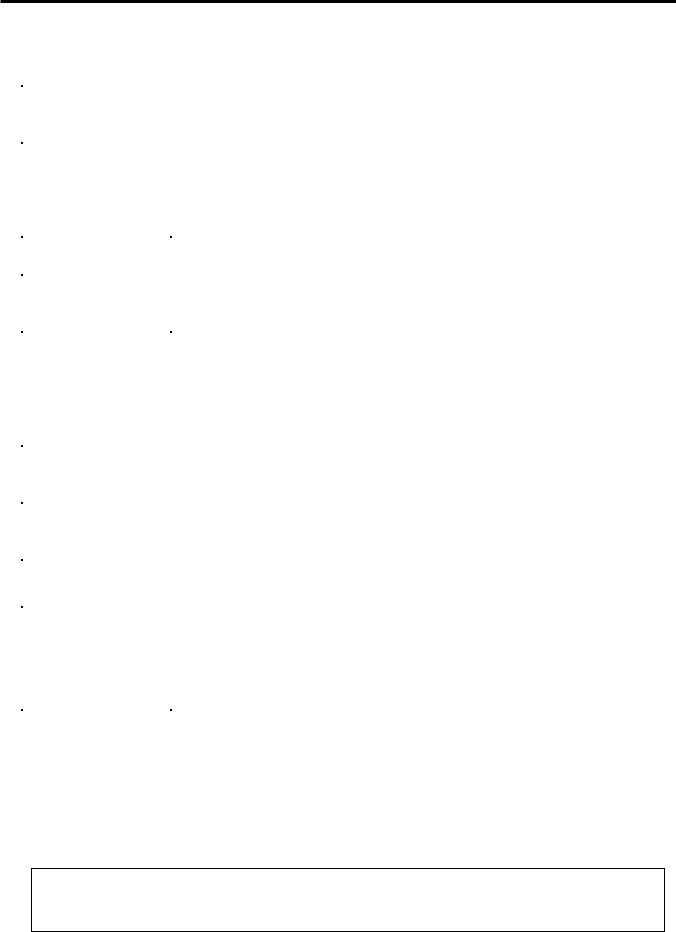
1. PRODUCT OVERVIEW |
ENGLISH VERSION EO1-33094 |
1.6 Options
Option Name |
Type |
Description |
|
|
|
|
|
Disc cutter |
Disc cutter module |
B-EX204-QM-R |
Each time media is cut, the media feed is |
|
|
stopped. |
Strip module |
B-EX904-H-QM-R |
This allows use of on-demand (peel-off) |
|
|
operation or to take-up labels and backing |
|
|
paper together when using the rewind guide |
|
|
plate. To purchase the strip module, please |
|
|
inquire with your local distributor. |
RFID module mount |
B-EX700-RFID-H1-QM- |
This kit is to mount Tagsys HF band RFID |
kit |
R |
module and antenna. |
203-dpi print head |
B-EX704-TPH2-QM-R |
This print head enables a conversion of a |
|
|
300dpi print head of the B-EX4T2-TS12 model |
|
|
into 203dpi print head. |
300-dpi print head |
B-EX704-TPH3-QM-R |
This print head enables a conversion of a |
|
|
203dpi print head of the B-EX4T2-GS12 model |
|
|
into 300dpi print head. |
600-dpi print head |
B-EX704-TPH6-QM-R |
Only with B-EX4T2-HS12 Model |
|
|
|
RTC & USB host |
B-EX700-RTC-QM-R |
This card holds the current time: year, month, |
interface card |
|
day, hour, minute, second and provides a USB |
|
|
host interface. |
Expansion I/O |
B-EX700-IO-QM-R |
Installing this card in the printer allows |
interface card |
|
connection to an external device with the |
|
|
exclusive interface. |
Parallel interface |
B-EX700-CEN-QM-R |
Installing this card provides a Centronics |
card |
|
interface port. |
|
|
|
Serial interface card |
B-EX700-RS-QM-R |
Installing this card provides an RS-232C |
|
|
interface port. |
|
|
|
Wireless LAN |
B-EX700-WLAN-QM-R |
Installing this card provides Wireless LAN |
interface card |
|
communication. |
|
|
|
NOTE:
To purchase the optional kits, please contact the nearest authorised TOSHIBA TEC representative or TOSHIBA TEC Head Quarters.
E1- 5
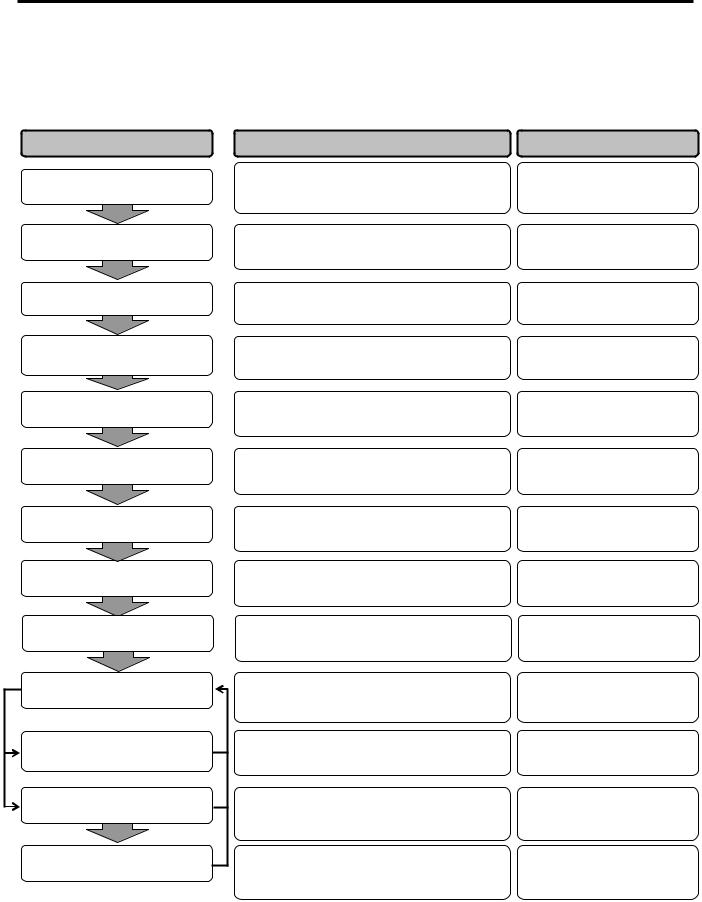
2. PRINTER SETUP |
ENGLISH VERSION EO1-33094 |
2. PRINTER SETUP
2. PRINTER SETUP
This section outlines the procedures to setup your printer prior to its operation. The section includes precautions, loading media and ribbon, connecting cables, setting the operating environment of the printer and performing an online print test.
Setup Flow
Installation
Connecting the power cord
Loading the media
Media sensor position alignment
Loading the ribbon
Connecting to a host computer
Turning the power ON
Printer setting
Installing the printer driver
Print test
Position and Print Tone Fine
adjustment
Automatic threshold setting
Manual threshold setting
Procedure
After referring to the Safety Precautions in this manual, install the printer in a safe and stable location.
Connect a power cord to the power inlet of the printer, then to an AC outlet.
Load a label stock or tag stock.
Adjust the position of feed gap sensor or black mark sensor according to the media being used.
If using thermal transfer media then load the ribbon.
Connect the printer to a host computer or network.
Turn on the printer power.
Set the printer parameters in the system mode.
If necessary, install the printer driver on your host computer.
Make a print test from your operating environment and check the print result.
If necessary, fine adjust the print start position, cut/strip position, print tone, etc.
If the print start position cannot be detected properly when pre-printed label are used, set the threshold automatically.
If the print start position cannot be detected properly even after automatic threshold setting is performed manually set the threshold.
Reference
2.1Installation
2.2Connecting the Power Cord
2.3.1 Loading the Media
2.3.1Loading the Media
2.3.2Loading the Ribbon
2.4Connecting the Cables to Your Printer
2.5Turning the Printer ON/OFF
2.6Printer Setting
2.7Installing the Printer Drivers
2.8Print Test
2.9Position and Print Tone Fine Adjustment
2.10Threshold Setting
2.10 Threshold Setting
E2- 1

2. PRINTER SETUP |
ENGLISH VERSION EO1-33094 |
2.1 Installation
2.1 Installation
To insure the best operating environment and to assure the safety of the operator and equipment, please observe the following precautions.
•Operate the printer on a stable, level surface in a location free from excessive humidity, high temperature, dust, vibration and direct sunlight.
•Keep your work environment static free. Static discharge can cause damage to delicate internal components.
•Make sure the printer is connected to a clean source of AC power and no other high-voltage devices, that may cause line noise interference, are connected to the same mains.
•Assure that the printer is connected to the AC mains with a threeprong power cable that has the proper ground (earth) connection.
•Do not operate the printer with the cover open. Be careful not to allow fingers or articles of clothing to get caught in any of the moving parts, especially the optional cutter mechanism.
•For best results, and longer printer life, use only TOSHIBA TEC recommended media and ribbons.
•Store the media and ribbons in accordance with their specifications.
•This printer mechanism contains high-voltage components; therefore you should never remove any of the covers of the machine as you may receive an electrical shock. Additionally, the printer contains many delicate components that may be damaged if accessed by unauthorised personnel.
•Clean the outside of the printer with a clean, dry cloth or a clean cloth slightly dampened with a mild detergent solution.
•Use caution when cleaning the thermal print head as it will become very hot while printing. Wait until it has had time to cool before cleaning. Use only the TOSHIBA TEC recommended print head cleaner to clean the print head.
•Do not turn off the printer power or remove the power plug while the printer is printing or while the ON LINE lamp is flashing.
E2- 2

2. PRINTER SETUP |
ENGLISH VERSION EO1-33094 |
2.2 Connecting the Power Cord
2.2Connecting the Power Cord
CAUTION!
1.Make sure that the printer Power Switch is turned to the OFF position ( ) before connecting the Power Cord to prevent possible electric shock or damage to the printer.
2.Connect the Power Cord to a supply outlet with a properly grounded (earthed) connection.
1.Make sure that the printer Power Switch is in the OFF ( ) position. Connect the Power Cord to the printer as shown in the figure below.
Power Cord
Power Switch
2.Plug the other end of the Power Cord into a grounded outlet as shown in the figure below.
Power Cord |
Power Cord |
|
[Example of US Type] |
[Example of EU Type] |
E2- 3
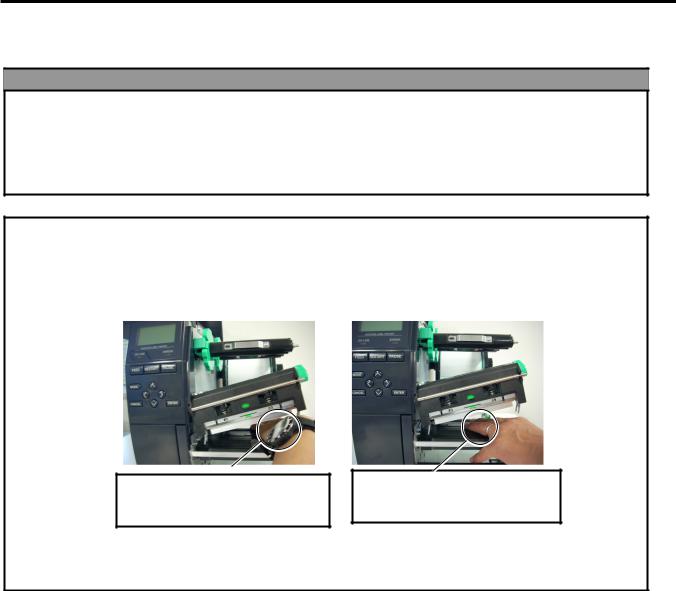
2. PRINTER SETUP |
ENGLISH VERSION EO1-33094 |
2.3 Loading Supplies
2.3 Loading Supplies
WARNING!
1.Do not touch any moving parts. To reduce the risk of fingers, jewellery, clothing, etc., being drawn into the moving parts, be sure to load the media once the printer has stopped moving completely.
2.The Print Head becomes hot immediately after printing, allow it to cool before loading the media.
3.To avoid injury, be careful not to trap your fingers while opening or closing the cover.
CAUTION!
1.Be careful not to touch the Print Head Elements when lifting the Print Head Block. This may cause missing dots due to static electricity or other print quality problems.
2.When loading or replacing the media or ribbon, be careful not to damage the print head with hard objects like watches or rings.
Care must be taken not to allow the metal or glass part of a watch to touch the print head edge.
Care must be taken not to allow a metal object like a ring to touch the print head edge.
Since the print head element can be easily damaged by shock, please treat it carefully and do not hit it with hard objects .
E2- 4
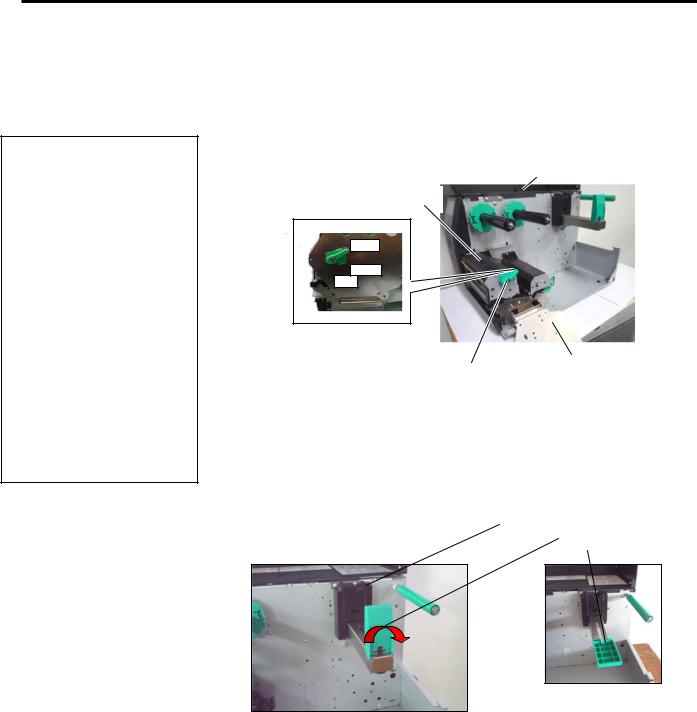
2. PRINTER SETUP
ENGLISH VERSION EO1-33094
2.3 Loading Supplies
2.3.1 Loading the Media
NOTES:
1.When the Head Lever is turned to FREE position, the Print Head can be raised.
2.To enable printing the Head Lever must be set to the
LABEL / TAG position. (This ensures that the Print Head is closed.)
There are two head pressure levels in the LABEL / TAG position. Set the Head Lever depending on the media type: Position LABEL: Labels
Position TAG : Tags However, proper position may differ depending on media. For details, refer to your TOSHIBA TEC authorised service representative.
The following procedure shows the steps to properly load the media into the printer so that it feeds straight through the printer.
The printer prints both labels and tags.
1.Open the Top Cover.
2.Turn the Head Lever to the FREE position and release the Ribbon Shaft Holder Plate.
3.Open the Print Head Block.
Top Cover
Print Head Block
FREE
LABEL
TAG
Ribbon Shaft Holder Plate
Head
Lever
4.Move the Paper guide R to the rightmost position or shift the guide to the horizontal position.
Paper Guide L
Paper Guide R
5.Put the media on the Paper Holder.
6.Pass the media around the Paper Holder, and then pull the media towards the front of the printer.
7.Push the Paper Guide against the media until the media is held firmly in place. To lock the Media, shift the Paper Guide R to vertical position
E2- 5
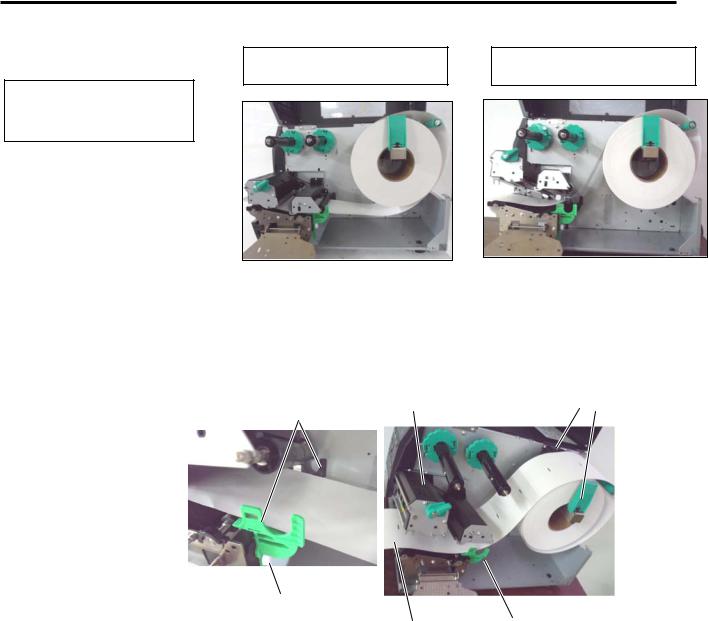
2. PRINTER SETUP
ENGLISH VERSION EO1-33094
2.3 Loading Supplies
2.3.1Loading the Media (Cont.)
NOTE:
Do not over-tighten the Locking Ring of the Supply Holder.
In the case of labels rolled with the print side facing inside.
In the case of labels rolled with the print side facing outside.
8.Place the media between the Media Guides and adjust them to the media width. Once in the correct position tighten the Locking Screw.
9.Check that the media’s path through the printer is straight. The media should be to the left side of the print head
|
|
Print Head |
Paper Guide |
|
Media Guide |
|
|
||
|
|
|
|
|
|
|
|
|
|
|
|
|
|
|
Locking Screw
Media |
Media Guide |
E2- 6

2. PRINTER SETUP
ENGLISH VERSION EO1-33094
2.3 Loading Supplies
2.3.1Loading the Media (Cont.)
10.Lower the Print Head Block.
11.Once the media is loaded it may be necessary to set the Media Sensors used to detect the start position for label or tag.
Setting the Feed Gap Sensor position
(1)Manually move the Media Sensor so that the Feed Gap Sensor is positioned at the centre of the labels. (z indicates the position of the Feed Gap Sensor).
Gap
NOTE:
Be sure to set the black mark sensor to detect the centre of the black mark, otherwise a paper jam or no paper error may occur.
Label |
Media Sensor |
Feed Gap Sensor (z) |
|
|
Setting the Black Mark Sensor position
(1)Pull about 500 mm of media out of the front of the printer, turn the media back on itself and feed it under the Print Head past the sensor so that the black mark can be seen from above.
(2)Manually move the Media Sensor so that the Black Mark Sensor is in line with the centre of the black mark on the media. ( indicates the position of the Black Mark Sensor).
Black Mark
Media |
Black Mark Sensor ( ) |
Media Sensor |
E2- 7
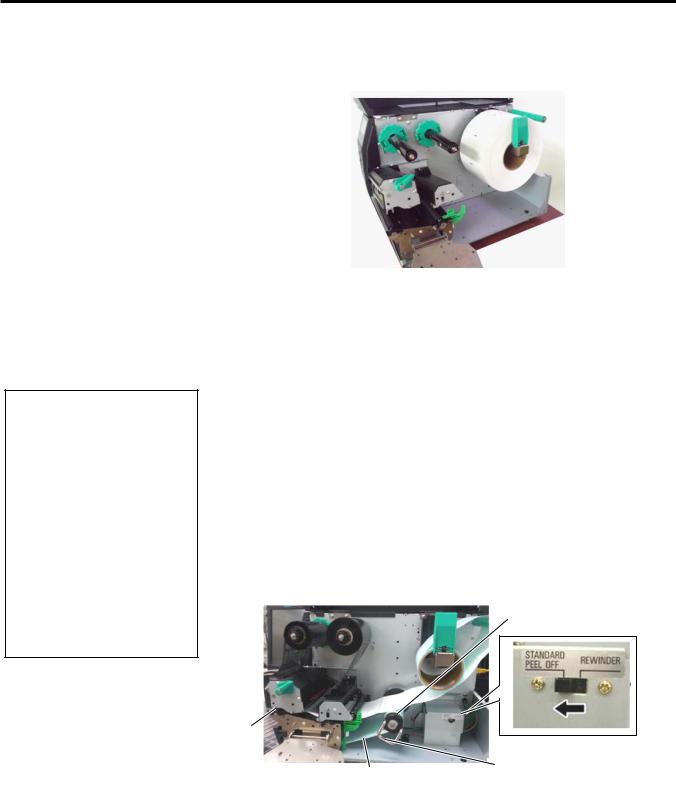
2. PRINTER SETUP
ENGLISH VERSION EO1-33094
2.3 Loading Supplies
2.3.1Loading the Media (Cont.)
NOTES:
1.Be sure to set the Selection Switch to STANDARD/ PEEL OFF position.
2.The backing paper is easier to feed back to the Take-Up Spool if the Front Plate is removed.
3.Fit the Take-Up Clip so that the longer side of the clip is fitted into the shallow groove in the Take-Up Spool.
4.The backing paper can be wound directly onto the Take-up Spool or a paper core.
12.Batch mode
In batch mode, the media is continuously printed until the number of labels/tags specified in the issue command has been printed.
13.Loading with peel off module
When the optional Strip Module is fitted, the label is automatically removed from the backing paper at the Strip Plate as each label is printed.
(1)Remove enough labels from the leading edge of the media to leave 500mm of backing paper free.
(2)Insert the backing paper under the Strip Plate.
(3)Wind the backing paper onto the Take-up Spool and fix it in position with the Take-up Clip. (Wind the paper counter-clockwise around the spool.)
(4)Rotate the Take-up Spool counter-clockwise a few times to remove any slack in the backing paper.
(5)Set the Selection Switch mounted on the Rewinder Assembly to
STANDARD/PEEL OFF position.
Take-up Spool
Strip Plate
Take-up Clip
Backing Paper
E2- 8

2. PRINTER SETUP
ENGLISH VERSION EO1-33094
2.3 Loading Supplies
2.3.1Loading the Media (Cont.)
WARNING!
The cutter is sharp, so care must be taken not to injure yourself when handling the cutter.
CAUTION!
1.Be sure to cut the backing paper of the label. Cutting labels will cause the glue to stick to the cutter which may affect the cutter quality and shorten the cutter life.
2.Use of tag paper when the thickness exceeds the specified value may affect the cutter life.
14. Loading with cutter
When the optional Cutter Module is fitted, the media is automatically cut. A disc cutter is available as option.
Insert the leading edge of the media into the cutter until it comes out the Media Outlet of the Cutter Module.
Cutter Module
Media Outlet
E2- 9

2. PRINTER SETUP
ENGLISH VERSION EO1-33094
2.3 Loading Supplies
2.3.2 Loading the Ribbon
NOTES:
1.When attaching the ribbon stoppers, make sure that the pinchers face into the printer
2.Be sure to remove any slack in the ribbon before printing. Printing with a wrinkled ribbon will reduce the print quality.
3.The Ribbon Sensor is mounted on the rear of the Print Head Block to detect a ribbon end. When a ribbon end is detected a “NO RIBBON” message will appear on the display and the ERROR LED will illuminate.
There are two types of media available for printing on: thermal transfer and direct thermal (which has a chemically treated surface). DO NOT LOAD a ribbon when using direct thermal media.
1. Grasp the tabs on the top and bottom of the Ribbon Stoppers and move the Ribbon Stoppers back to the end of the Ribbon Shaft.
Ribbon Stopper
Ribbon Shaft
2. Leaving plenty of slack between the ribbon spools, place the ribbon onto the Ribbon Shafts as shown below. There are 2 possible ways to load the ribbon.
Ribbon Shaft
Ribbon Shaft
Print Head Block
Outside Wound Ribbon
Inside Wound Ribbon
NOTE:
To check or change settings on which type of Ribbon winding to be used, you must go to SYSTEM Mode in the Printer. For more details refer to Key Operation Specification, “8.4.1 PRINTER SET”.
E2-10
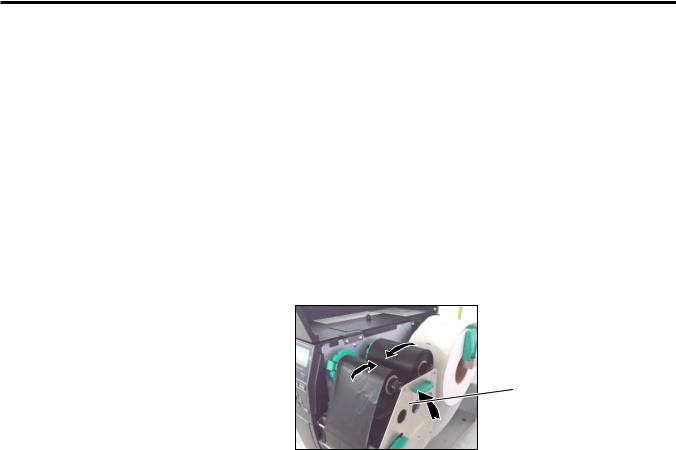
2. PRINTER SETUP
ENGLISH VERSION EO1-33094
2.3 Loading Supplies
3.Push Ribbon along the Ribbon Shafts to a position where the
2.3.2Loading the Ribbon ribbon is fully to the Left against the stoppers when fitted.
(Cont.)
4.Lower the Print Head Block and set the Ribbon Shaft Holder Plate aligning its holes with the Ribbon Shafts.
5.Take up any slack in the ribbon. Wind the leading tape onto the ribbon take-up roll until the ink ribbon can be seen from the front of the printer.
Ribbon Shaft Holder Plate
6.Turn the Head Lever to Lock position to close the Print Head.
7.Close the Top Cover.
E2-11

2. PRINTER SETUP
ENGLISH VERSION EO1-33094
2.4 Connecting the Cables to Your Printer
2.4Connecting the Cables to Your Printer
The following paragraphs outline how to connect the cables from the printer to your host computer, and will also show how to make cable connections to other devices. Depending on the application software you use to print labels, there are 5 ways to connect the printer to your host computer. These are:
•An Ethernet connection using the printer’s standard LAN connector.
•A USB cable connection between the printer’s standard USB connector and your host computer’s USB port. (Conforming to USB 2.0)
•A serial cable connection between the printer’s optional RS232 serial connector and one of your host computer’s COM ports.
•A parallel cable connection between the printer’s optional parallel connector and your host computer’s parallel port (LPT).
•Wireless LAN using an optional Wireless LAN board.
For details, refer to APPENDIX 2.
Reserved for |
Reserved for Serial or |
|
WLAN Interface |
||
Parallel Interface |
||
|
||
|
USB Interface |
|
|
|
|
|
Reserved for USB Host |
|
|
interface |
|
|
|
|
|
Reserved for |
|
|
Expansion I/O Interface |
|
|
LAN Interface |
|
|
Power Switch |
|
|
AC Power Inlet |
E2-12

2. PRINTER SETUP
ENGLISH VERSION EO1-33094
2.5 Turning the Printer ON/OFF
2.5Turning the Printer ON/OFF
When the printer is connected to your host computer it is good practice to turn the printer ON before turning on your host computer and turn OFF your host computer before turning off the printer.
2.5.1 Turning ON the Printer
CAUTION!
Use the power switch to turn the printer On/Off. Plugging or unplugging the Power Cord to turn the printer On/Off may cause fire, an electric shock, or damage to the printer.
NOTE:
If a message other than ON LINE appears on the display or the ERROR LED lamp is illuminated, refer to Section 5.1, Error Messages.
1.To turn ON the printer power, press the Power Switch as shown in the diagram below. Note that ( | ) is the power ON side of the switch.
 Power Switch
Power Switch
2.Check that the ON LINE message appears in the LCD Message Display and that the ON LINE and POWER LED lights are illuminated.
2.5.2 Turning OFF the Printer
CAUTION!
1.Do not turn off the printer power while the media is being printed, as this may cause a paper jam or damage to the printer.
2.Do not turn off the printer power while the ON LINE lamp is blinking as this may cause damage to your computer.
1.Before turning off the printer Power Switch verify that the ON LINE message appears in the LCD Message Display and that the ON LINE LED light is on and is not flashing.
2.To turn OFF the printer power press the Power Switch as shown in the diagram below. Note that ({) is the power OFF side of the switch.
Power Switch
E2-13

2. PRINTER SETUP
ENGLISH VERSION EO1-33094
2.6 Printer Setting
2.6 Printer Setting |
Depending on the settings of your host computer or the interface |
|
|
being used it may be necessary to change the printer parameter |
|
|
settings. |
|
|
Follow the procedures described below to change the printer |
|
|
parameter settings to correspond to your environment. |
|
|
|
|
|
|
NOTE: |
|
|
Incorrect settings can cause the printer not to function correctly. If |
|
|
you have any problems with the parameter settings, please contact |
|
|
your nearest TOSHIBA TEC service representative. |
|
|
For the settings this manual does not cover, please contact your |
|
|
nearest TOSHIBA TEC service representative, or refer to the B-EX4T |
|
|
Series Key Operation Specification manual. |
|
|
|
Power OFF |
Power ON |
ONLINE Mode |
 [PAUSE]
[PAUSE]
PAUSE state
Hold down [RESTART]
User System Mode
Hold down [MODE]
Turn on the power while holding down [FEED] & [PAUSE] or [MODE].
•Reset
•Parameter setting ( Section 2.6.2)
•Fine adjustment ( Section 2.9)
•LAN/WLAN ( Section 2.6.3)
•BASIC ( Section 2.6.4)
•Z-MODE ( Section 2.6.5)
•Auto calibration ( Section 2.6.6)
•Dump mode ( Section 2.6.7)
•Log ( Section 2.6.8)
System Mode |
|
• Self diagnosis |
|
||
|
|
• Parameter setting |
|
||
|
|
• Fine adjustment |
|
|
• Test print ( Section 2.8) |
|
|
• Sensor adjustment |
|
|
• RAM clear |
|
|
• Interface setting ( Section 2.6.10) |
|
|
• BASIC mode |
|
|
• RFID setting |
|
|
• Real Time Clock ( Section 2.6.11) |
|
|
• Z-MODE |
|
|
• USB memory ( Section 2.6.12) |
|
|
• Reset |
E2-14

2. PRINTER SETUP
ENGLISH VERSION EO1-33094
2.6 Printer Setting
2.6 Printer Setting |
|
|
Key functions in system mode |
|||||||
|
(Cont.) |
|
|
|
|
|
||||
|
|
|
Key |
Function |
||||||
|
|
|
|
|
|
|
|
|
[MODE] |
Returns to the system mode menu. |
|
|
|
|
|
|
|
|
|
[CANCEL] or |
Returns to the previous menu. |
|
|
|
|
|
|
|
|
|
[FEED]+[RESTAR] |
|
|
|
|
|
|
|
|
|
|
[ENTER] or |
Displays the next screen. |
|
|
|
|
|
|
|
|
|
[PAUSE] |
Saves the settings and returns to the |
|
|
|
|
|
|
PAUSE |
|
|
previous menu. |
|
|
FEED |
|
[UP] or [RESTART] |
Moves the cursor up. (Note 1) |
||||||
|
|
|
|
|||||||
|
|
|
|
|
|
RESTART |
|
|
Increases a value. (Note 2) |
|
|
MODE |
|
|
|
|
|
|
[DOWN] or [FEED] |
Moves the cursor down. (Note 1) |
|
|
UP |
|
|
|||||||
|
|
|
|
|||||||
|
|
|
|
|
|
|
|
|
Decreases a value. (Note 3) |
|
|
|
|
|
|
|
|
|
|
|
|
|
|
|
|
|
|
RIGHT |
|
|
||
|
LEFT |
|
|
|
|
|||||
|
[LEFT] |
Moves the cursor to the left. (Note 3) |
||||||||
|
|
|
|
|
|
|
|
|
|
|
CANCEL |
|
ENTER |
|
[RIGHT] |
Moves the cursor to the right. (Note 3) |
|||||
|
|
|
DOWN |
|
|
|
|
|
||
|
|
|
|
|
|
|
|
|
|
NOTES: |
1.The cursor will not scroll from the bottom to the top or top to bottom of a menu.
2.The value will not increase or decrease any further than the maximum or minimum values of a parameter.
3.The cursor will not move any further than the leftor right-most positions of a field.
4.Any values changed will not become effective if the printer is turned off without pressing the [ENTER] key.
2.6.1 User System Mode |
How to enter the User System Mode |
|||||||||||
|
|
|
|
|
|
|
|
|
|
|||
|
|
|
|
|
[PAUSE] |
|
Hold down [RESTART] |
|
|
|||
|
ONLINE |
|
|
|
|
|
|
|
|
|
|
User System Mode |
|
|
|
|
|
Hold down [MODE] |
|
|
|
||||
|
|
|
|
|
|
|
|
|
||||
|
|
|
|
|
|
|
|
|
|
|
|
|
The User System Mode consists of the following menus.
<1>RESET
Used to reset the printer.
<2>PARAMETER SET ( Section 2.6.2) Used to set the printer parameters.
<3>ADJUST SET ( Section 2.9)
Used to fine adjust the print start position, cut position, etc.
<4>LAN/WLAN ( Section 2.6.3)
Used to enable or disable the LAN communication and SNMP.
<5>BASIC ( Section 2.6.4)
Used to set the function of basic program when it is loaded to the printer.
<6>Z-MODE ( Section 2.6.5) Same as BASIC
<7>AUTO CALIB ( Section 2.6.6)
Used to enable or disable the automatic calibration function.
<8>DUMP MODE ( Section 2.6.6)
Used to print the data in the receive buffer for debugging purposes.
<9>LOG ( Section 2.6.7)
Used to save print logs in USB memory.
E2-15

2. PRINTER SETUP
ENGLISH VERSION EO1-33094
2.6 Printer Setting
2.6.2 Parameter Setting The Parameter Set menu allows the printer parameter settings to be modified.
USER SYSTEM MODE  <1>RESET
<1>RESET
 <2>PARAMETER SET
<2>PARAMETER SET
<3>ADJUST SET 
 <4>LAN/WLAN
<4>LAN/WLAN
The following table shows the contents of the Parameter Set menu.
Contents of the Parameter Set Menu
Menu |
Sub menu |
Parameter |
Parameter |
Printer Set |
MEDIA LOAD |
set |
(Section 2.6.2.1) |
FORWARD WAIT |
|
|
FW/BK ACT |
|
|
HU CUT/RWD |
|
|
RBN SAVE |
|
|
PRE PEEL OFF |
|
|
BACK SPEED |
|
Software Set |
FONT CODE |
|
(Section 2.6.2.2) |
TYPE OF RIBBON |
|
ZERO FONT |
|
|
|
CODE |
|
|
PEEL OFF STATUS |
|
|
USB I/F STATUS |
|
|
FEED KEY |
|
|
KANJI CODE |
|
|
EURO CODE |
|
|
AUTO HD CHK |
|
|
WEB PRINTER |
|
|
RBN NEAR END |
|
|
EX I/O |
|
|
LBL/RBN END |
|
|
MAX CODE |
|
|
XML |
|
|
THRESHOLD SELECT |
|
|
ENERGY TYPE |
|
|
PW SAVE TIME |
|
Panel |
LCD LANGUAGE |
|
(Section 2.6.2.3) |
DISPLAY |
|
|
CONTRAST |
|
Password |
PASSWORD |
|
(Section 2.6.2.4) |
|
E2-16
